E-commerce email marketing is a game-changer for online businesses looking to boost sales and engage customers effectively. In this comprehensive guide, we’ll delve into the essentials of e-commerce email marketing, exploring its importance, the best tools available, successful case studies, and answers to common questions. Whether you’re just starting or looking to optimize your current strategies, this post will provide valuable insights and practical tips to help you make the most of your email marketing efforts.
Importance of Email Marketing in E-commerce
In the fast-paced world of e-commerce, effective email marketing can be the difference between a thriving business and one that struggles to engage customers. Choosing the right email marketing tool is crucial for creating compelling campaigns, automating workflows, and driving sales. In this guide, we’ll introduce you to some of the top email marketing tools available today, each offering unique features and capabilities to meet the diverse needs of online businesses. Whether you’re a small startup or an established enterprise, these tools can help you optimize your email marketing strategy and achieve your business goals.
Direct Communication with Customers
Email marketing provides a direct line of communication with your customers. Unlike social media platforms where algorithms can limit your reach, emails are delivered straight to your customer’s inbox. This direct access ensures your messages are seen by your audience, making it a highly effective channel for e-commerce businesses.
High Return on Investment (ROI)
One of the most compelling reasons to invest in e-commerce email marketing is its impressive return on investment (ROI). According to studies, email marketing can yield an average ROI of $42 for every dollar spent. This high ROI is due to the low cost of sending emails compared to other marketing channels and the potential for significant revenue generation through targeted campaigns.
Personalization and Segmentation
Email marketing allows for a high degree of personalization and segmentation. You can tailor your messages based on customer behavior, preferences, and purchase history. This personalized approach increases the relevance of your emails, leading to higher open rates, click-through rates, and conversions. Segmentation allows you to send targeted messages to specific groups within your audience, ensuring that your emails are relevant and engaging.
Automation and Scalability
Email marketing tools offer robust automation features that save time and enhance efficiency. Automation allows you to set up email sequences that are triggered by specific actions, such as welcome emails, abandoned cart reminders, and post-purchase follow-ups. These automated campaigns ensure timely and consistent communication with your customers, helping to nurture relationships and drive sales.
Building Customer Loyalty
Regular, value-driven communication through email helps build and maintain customer loyalty. By consistently providing useful content, exclusive offers, and personalized recommendations, you can keep your customers engaged and coming back to your store. Loyalty programs and rewards shared via email can further incentivize repeat purchases and foster long-term customer relationships.
Driving Traffic and Sales
Emails are a powerful tool for driving traffic to your e-commerce site. By including clear calls to action (CTAs) and linking to product pages, blog posts, or special promotions, you can guide recipients back to your site, increasing the chances of conversion. Additionally, email marketing campaigns can boost sales during key periods, such as holidays, sales events, and product launches.
Measuring and Optimizing Performance
Email marketing platforms provide detailed analytics and reporting features. These insights allow you to track the performance of your campaigns, including open rates, click-through rates, and conversion rates. By analyzing this data, you can identify what works and what doesn’t, enabling you to optimize future campaigns for better results.
Enhancing Brand Awareness
Regularly communicating with your audience through email helps to keep your brand top of mind. Consistent branding, messaging, and valuable content in your emails contribute to a strong brand presence. Over time, this increased brand awareness can lead to higher customer recognition and loyalty.
Top Email Marketing Tools for E-commerce Stores.
In the fast-paced world of e-commerce, effective email marketing can be the difference between a thriving business and one that struggles to engage customers. Choosing the right email marketing tool is crucial for creating compelling campaigns, automating workflows, and driving sales. In this guide, we’ll introduce you to some of the top email marketing tools available today, each offering unique features and capabilities to meet the diverse needs of online businesses. Whether you’re a small startup or an established enterprise, these tools can help you optimize your email marketing strategy and achieve your business goals.
1. AWeber
2. GetResponse
3. Constant Contact
4. Drip
5. Moosend
6. Sendinblue
7. MailerLite
1. AWeber
User Interface and Experience: AWeber offers a user-friendly interface with drag-and-drop email builders and pre-designed templates, making it easy for users of all levels to create professional emails. The dashboard is intuitive and simple to navigate.
Automation and Workflow Capabilities: AWeber provides robust automation features, including autoresponders, drip campaigns, and behavior-based triggers. This allows for efficient customer engagement and follow-up processes.
Customer Support and Resources: AWeber excels in customer support with 24/7 live chat, phone support, and email assistance. They also offer a comprehensive knowledge base, webinars, and video tutorials.
Pricing: AWeber’s pricing starts at $12.50/month for unlimited subscribers. They offer a free plan with limited features and various pricing tiers that scale with your subscriber count.
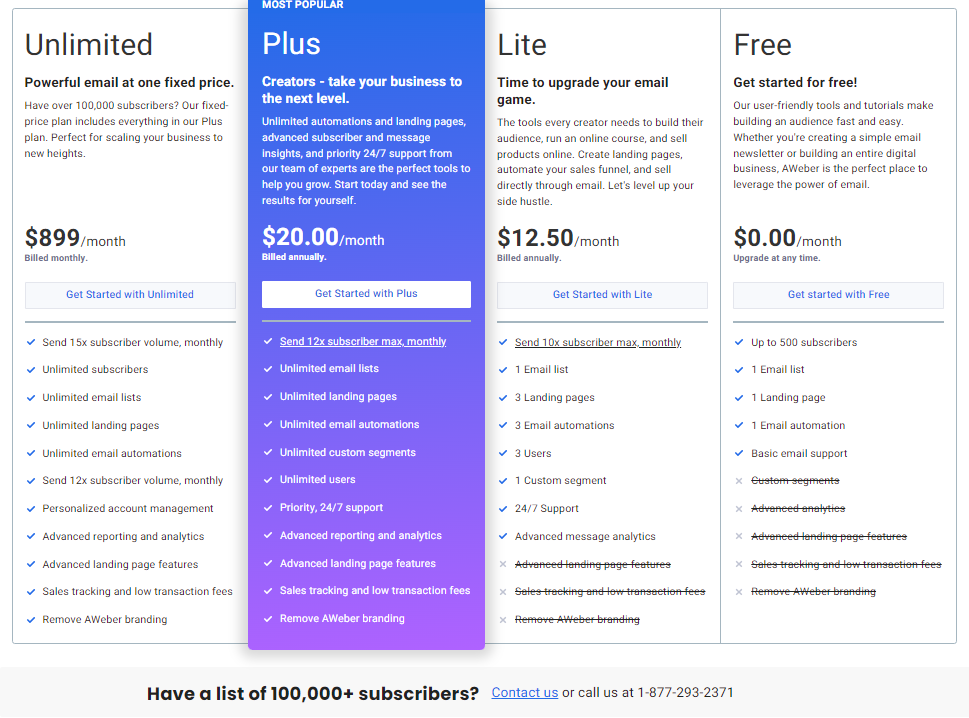
2. GetResponse
User Interface and Experience: GetResponse features a clean, modern interface that is easy to use. The drag-and-drop email editor and extensive template library streamline the email creation process.
Automation and Workflow Capabilities: GetResponse is known for its advanced automation features, including workflow automation, segmentation, and autoresponders. Their visual workflow builder allows for detailed campaign customization.
Customer Support and Resources: GetResponse offers 24/7 customer support via chat and email. They provide a rich array of resources, including webinars, guides, and a comprehensive help center.
Pricing: GetResponse’s pricing starts at $15.6/month. They also offer a 30-day free trial, and their pricing plans scale based on list size and feature access.
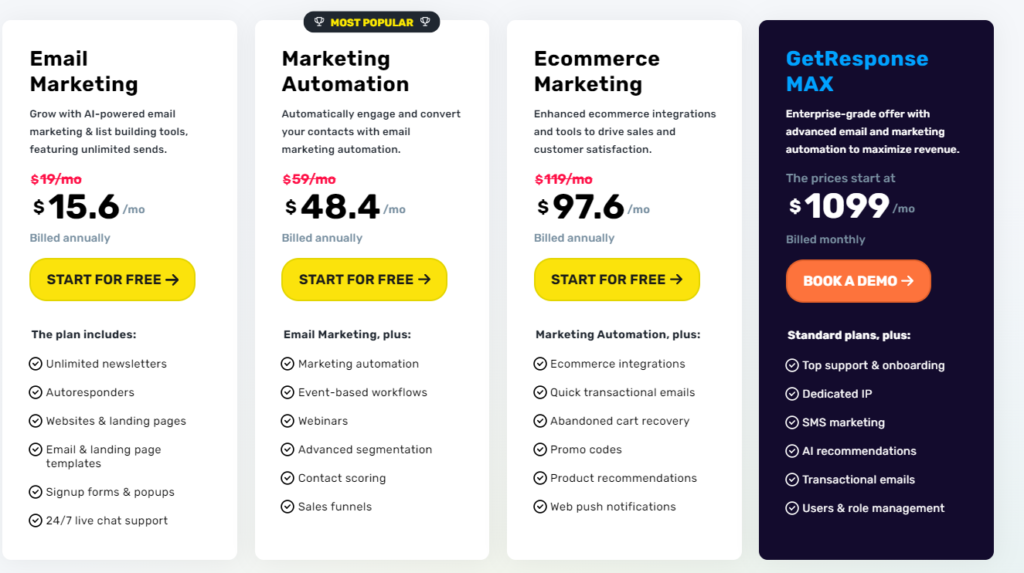
3. Constant Contact
User Interface and Experience: Constant Contact provides an intuitive interface with a straightforward email editor. Their drag-and-drop functionality and customizable templates make email creation simple.
Automation and Workflow Capabilities: Constant Contact offers basic automation features like welcome emails, autoresponders, and event-triggered emails. Their automation capabilities are suitable for small to mid-sized businesses.
Customer Support and Resources: They provide excellent customer support with phone, chat, and email assistance. Their extensive knowledge base, tutorials, and community forums are valuable resources.
Pricing: Pricing starts at $12/month for up to 500 contacts. They offer a 60-day free trial, and the cost increases based on the number of contacts and features.
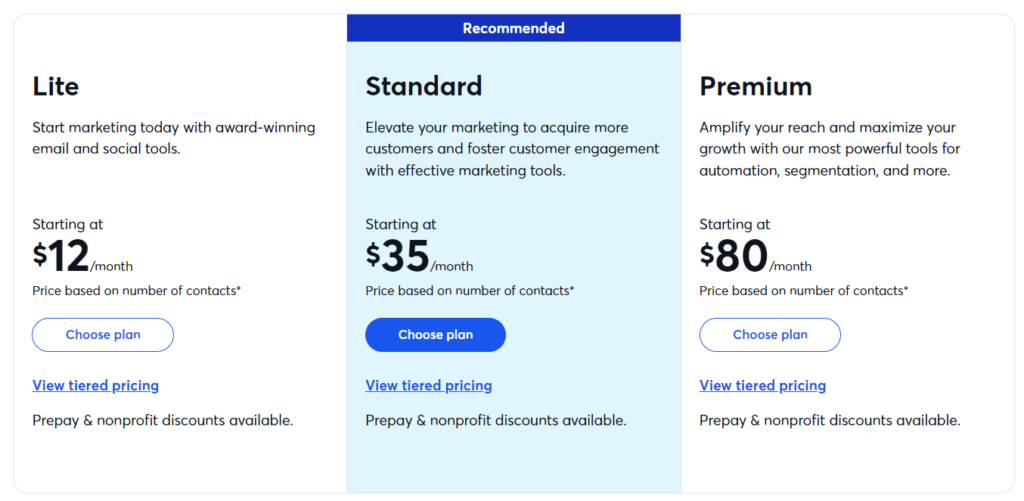
4. Drip
User Interface and Experience: Drip’s interface is sleek and user-friendly, designed specifically for e-commerce businesses. The visual email builder and pre-built templates enhance user experience.
Automation and Workflow Capabilities: Drip excels in automation with advanced workflow capabilities, behavior-based triggers, and personalized messaging. Their automation features are highly customizable.
Customer Support and Resources: Drip offers chat and email support along with a comprehensive knowledge base, webinars, and detailed guides. Their customer support is highly rated.
Pricing: Drip’s pricing starts at $39/month for up to 2,500 contacts. They provide a 14-day free trial, and the cost scales with the number of contacts and advanced features.
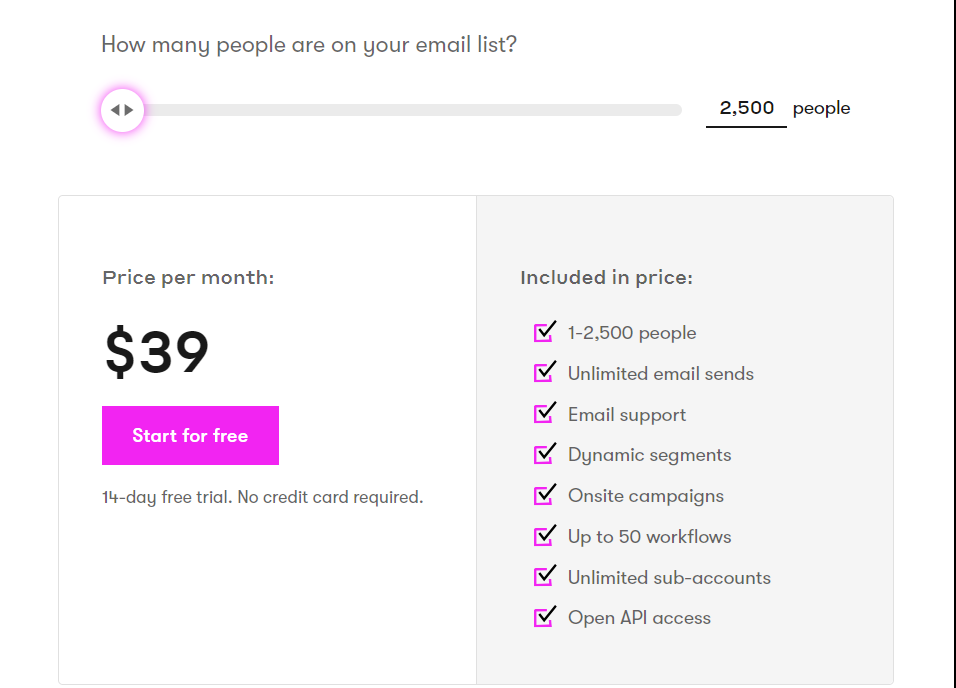
5. Moosend
User Interface and Experience: Moosend has a clean, easy-to-use interface with a drag-and-drop editor and a variety of templates. The platform is designed to be user-friendly for beginners.
Automation and Workflow Capabilities: Moosend offers powerful automation features, including workflow automation, segmentation, and personalization. Their automation editor is intuitive and effective.
Customer Support and Resources: They provide customer support via chat and email. Moosend also offers a rich knowledge base, tutorials, and video guides to help users get started.
Pricing: Moosend’s pricing starts at $5.74/month for up to 500 subscribers. They offer a free plan with basic features and various paid plans that scale with your subscriber list.
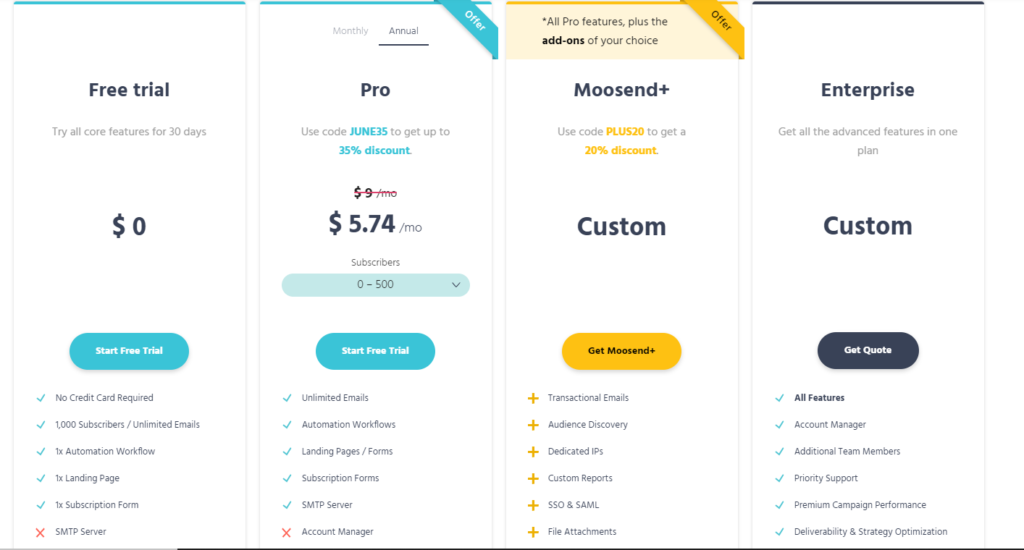
6. Sendinblue
User Interface and Experience: Sendinblue features an intuitive interface with a drag-and-drop editor and numerous templates. The platform is designed for ease of use and efficiency.
Automation and Workflow Capabilities: Sendinblue excels in automation, offering advanced workflow capabilities, segmentation, and behavior-based triggers. Their automation builder is powerful and versatile.
Customer Support and Resources: Sendinblue offers support via chat and email. They provide a comprehensive help center, tutorials, and webinars to assist users.
Pricing: Sendinblue’s pricing starts with a free plan for up to 300 emails per day. Paid plans begin at $25/month, with pricing scaling based on email volume and feature access.
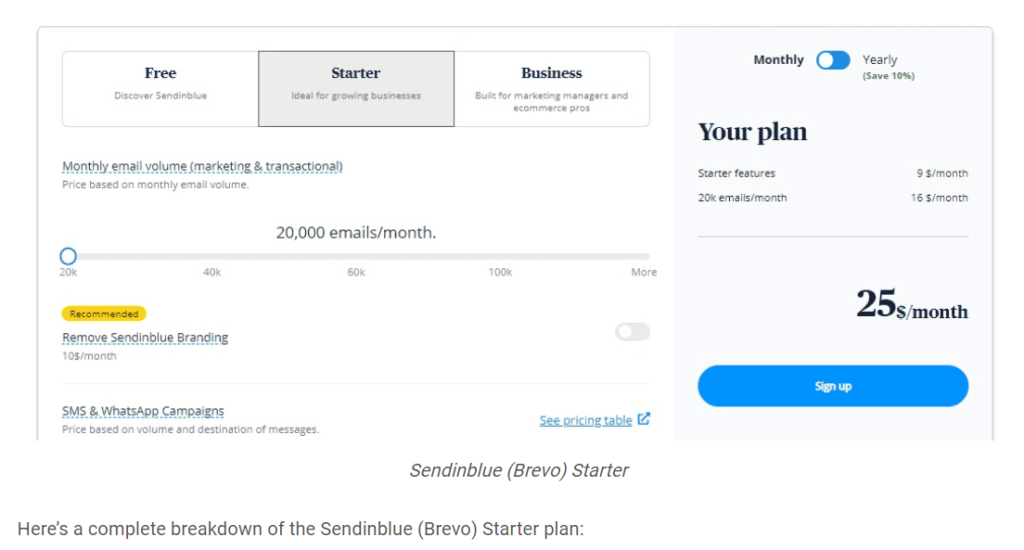
7. MailerLite
User Interface and Experience: MailerLite offers a user-friendly interface with a drag-and-drop editor and customizable templates. The platform is designed to be intuitive and accessible.
Automation and Workflow Capabilities: MailerLite provides robust automation features, including workflow automation, segmentation, and autoresponders. Their automation editor is straightforward and effective.
Customer Support and Resources: MailerLite provides support via email and chat. They offer a comprehensive knowledge base, video tutorials, and webinars to help users.
Pricing: MailerLite’s pricing starts with a free plan for up to 1,000 subscribers. Paid plans start at $9/month, with pricing increasing based on subscriber count and additional features.
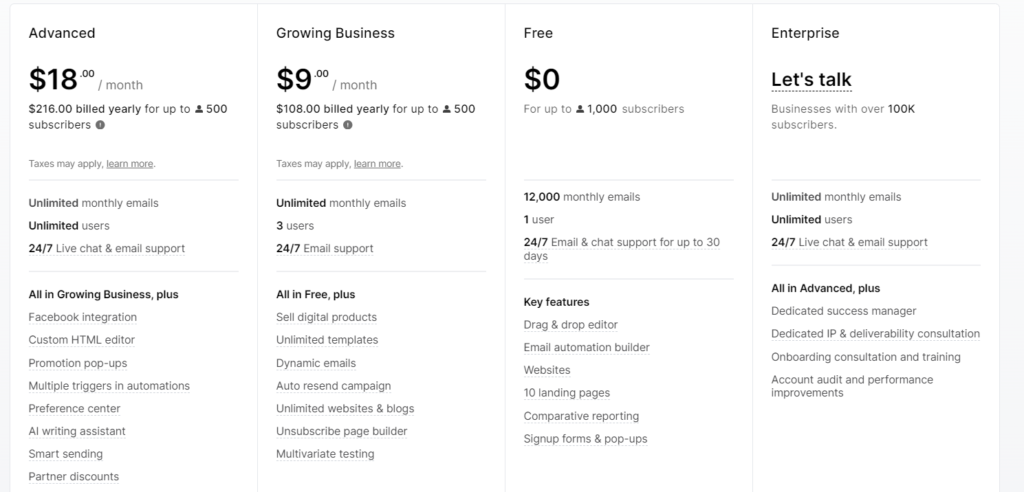
Case Studies of Successful E-commerce Email Campaigns
E-commerce email marketing is a powerful tool that can drive significant results when executed effectively. Here are some case studies of successful e-commerce email campaigns that demonstrate the impact of well-planned and executed email marketing strategies.
Case Study 1: Chubbies Shorts
Background: Chubbies Shorts, an e-commerce retailer specializing in men’s shorts, aimed to increase customer engagement and boost sales through email marketing.
Strategy: Chubbies implemented a humor-driven email marketing campaign. They used quirky and relatable content to engage their audience, coupled with eye-catching designs and clear calls to action. They segmented their email list to tailor content to different customer groups based on purchase history and engagement levels.
Results:
- Open Rates: Increased by 50%
- Click-Through Rates: Improved by 35%
- Sales: Boosted by 25% during the campaign period
The campaign’s success was attributed to the engaging content and targeted segmentation, which resonated well with their audience.
Case Study 2: MeUndies
Background: MeUndies, a popular subscription-based underwear retailer, aimed to reduce cart abandonment rates and recover lost sales through email marketing.
Strategy: MeUndies implemented a series of automated abandoned cart emails. The emails included personalized product recommendations, enticing discount codes, and a sense of urgency to encourage customers to complete their purchases. They tested different subject lines and email designs to optimize performance.
Results:
- Cart Recovery Rate: Increased by 15%
- Conversion Rate: Improved by 20%
- Revenue: Generated an additional $150,000 in recovered sales over three months
The campaign’s effectiveness was driven by personalized content and timely follow-ups, which successfully re-engaged customers.
Case Study 3: Dollar Shave Club
Background: Dollar Shave Club, a subscription service for razors and personal grooming products, wanted to boost subscriber retention and increase customer lifetime value through email marketing.
Strategy: Dollar Shave Club launched a re-engagement campaign targeting inactive subscribers. They sent a series of emails highlighting the benefits of staying subscribed, offering exclusive content, and providing special discounts to re-engage users. The campaign also included surveys to gather feedback and understand reasons for inactivity.
Results:
- Re-engagement Rate: Increased by 40%
- Subscriber Retention: Improved by 30%
- Customer Lifetime Value: Increased by 10%
By focusing on customer engagement and personalized incentives, Dollar Shave Club successfully reactivated a significant portion of their subscriber base.
Case Study 4: ASOS
Background: ASOS, a global online fashion retailer, aimed to drive sales during the holiday season through a targeted email marketing campaign.
Strategy: ASOS created a holiday-themed email campaign featuring gift guides, exclusive holiday discounts, and personalized recommendations. They used dynamic content to tailor emails based on customer preferences and past purchases. The campaign also included interactive elements like countdown timers to create urgency.
Results:
- Open Rates: Increased by 45%
- Click-Through Rates: Improved by 50%
- Sales: Increased by 35% during the holiday season
The combination of festive themes, personalized content, and interactive elements made the campaign highly effective in boosting holiday sales.
Case Study 5: TOMS Shoes
Background: TOMS Shoes, known for its one-for-one giving model, sought to increase customer loyalty and repeat purchases through an email marketing campaign.
Strategy: TOMS implemented a loyalty program promoted through email marketing. They sent regular updates about the program, exclusive offers for members, and stories highlighting the impact of their purchases. The emails also featured personalized product recommendations based on browsing history.
Results:
- Loyalty Program Sign-ups: Increased by 30%
- Repeat Purchase Rate: Improved by 25%
- Customer Engagement: Boosted by 40%
The campaign’s success was driven by the emotional appeal of their giving model, personalized offers, and engaging storytelling.
Common Questions about E-commerce Email Marketing
E-commerce email marketing is a vital tool for online businesses looking to engage customers, drive sales, and build brand loyalty. However, many business owners and marketers have questions about how to effectively implement and optimize their email marketing strategies. Here are some common questions about e-commerce email marketing, along with clear and concise answers.
1. What is e-commerce email marketing?
E-commerce email marketing involves using email campaigns to promote products, engage customers, and drive sales for online stores. It includes various types of emails, such as promotional emails, newsletters, abandoned cart reminders, and personalized product recommendations.
2. Why is e-commerce email marketing important?
E-commerce email marketing is crucial because it allows businesses to directly reach their customers, promote products, and generate sales. It has a high return on investment (ROI), enables personalized communication, and helps build long-term customer relationships.
3. How often should I send marketing emails?
The frequency of marketing emails depends on your audience and the type of content you provide. A common practice is to send 1-2 emails per week. It’s essential to maintain a balance to avoid overwhelming your subscribers while keeping them engaged.
4. What types of emails should I include in my e-commerce email marketing strategy?
Your e-commerce email marketing strategy should include a variety of emails to address different customer needs and stages of the buying journey. Common types include:
- Welcome Emails: To greet new subscribers and introduce your brand.
- Promotional Emails: To announce sales, discounts, and new products.
- Abandoned Cart Emails: To remind customers of items left in their shopping cart.
- Order Confirmation and Shipping Updates: To keep customers informed about their purchases.
- Newsletters: To provide valuable content and keep your audience engaged.
- Re-engagement Emails: To win back inactive subscribers.
5. How can I improve my email open rates?
To improve email open rates, consider the following tips:
- Craft Compelling Subject Lines: Make them intriguing and relevant.
- Segment Your Audience: Send targeted emails to specific groups based on their behavior and preferences.
- Personalize Your Emails: Use the recipient’s name and tailor the content to their interests.
- Optimize Send Times: Test different times to see when your audience is most likely to open emails.
- Ensure Mobile Friendliness: Many users check emails on mobile devices, so make sure your emails look good on smaller screens.
6. What is email segmentation, and why is it important?
Email segmentation is the practice of dividing your email list into smaller groups based on specific criteria, such as demographics, purchase history, or engagement level. Segmentation is important because it allows you to send more relevant and personalized emails, which can lead to higher open rates, click-through rates, and conversions.
7. How can I reduce email unsubscribes?
To reduce email unsubscribes, consider the following strategies:
- Provide Value: Ensure your emails offer valuable content, such as discounts, useful information, or exclusive offers.
- Set Expectations: Clearly communicate what type of content subscribers will receive and how often.
- Personalize Content: Tailor emails to the recipient’s preferences and behavior.
- Make Unsubscribing Easy: Provide a simple and straightforward way to unsubscribe, which can enhance trust and reduce frustration.
8. What is the role of automation in e-commerce email marketing?
Automation plays a crucial role in e-commerce email marketing by streamlining and optimizing the process of sending emails. It allows you to set up automated workflows, such as welcome series, abandoned cart reminders, and re-engagement campaigns, which are triggered by specific customer actions or events. This ensures timely and relevant communication with minimal manual effort.
9. How can I measure the success of my e-commerce email marketing campaigns?
To measure the success of your email marketing campaigns, track key metrics such as:
- Open Rates: The percentage of recipients who open your emails.
- Click-Through Rates (CTR): The percentage of recipients who click on links within your emails.
- Conversion Rates: The percentage of recipients who complete a desired action, such as making a purchase.
- Bounce Rates: The percentage of emails that couldn’t be delivered.
- Unsubscribe Rates: The percentage of recipients who unsubscribe from your email list.
10. What are some best practices for e-commerce email marketing?
Some best practices for e-commerce email marketing include:
- Segmenting Your Audience: Send targeted and relevant emails.
- Personalizing Content: Tailor emails to individual preferences and behavior.
- Testing and Optimizing: Continuously test different elements (subject lines, content, send times) and optimize based on results.
- Using Clear Calls to Action (CTAs): Ensure your emails have clear and compelling CTAs to drive conversions.
- Maintaining Clean Lists: Regularly update and clean your email list to remove inactive subscribers and ensure deliverability.
Conclusion
E-commerce email marketing is an indispensable strategy for online businesses looking to maximize their reach, engage customers, and drive sales. Throughout this blog post, we’ve explored various aspects of e-commerce email marketing, including its importance, effective use cases, key features of top email marketing tools, and common questions that arise when implementing these strategies.
By leveraging the right email marketing tools—such as AWeber, GetResponse, Constant Contact, Drip, Moosend, Sendinblue, and MailerLite—you can benefit from user-friendly interfaces, powerful automation capabilities, robust customer support, and scalable pricing plans. Each of these tools offers unique strengths that can cater to different business needs and objectives.
Case studies of successful e-commerce email campaigns demonstrate the tangible benefits of targeted and well-executed email strategies. From improving open rates and click-through rates to driving significant sales and re-engaging inactive customers, these examples highlight the potential of email marketing to transform your e-commerce business.
In addressing common questions about e-commerce email marketing, we’ve provided insights into best practices, essential metrics to track, and tips for optimizing your campaigns. Understanding these fundamentals will help you create effective email marketing strategies that resonate with your audience and yield measurable results.
As you move forward with your e-commerce email marketing efforts, remember to focus on personalization, segmentation, and automation. These elements will ensure that your messages are relevant, timely, and engaging, ultimately leading to stronger customer relationships and increased revenue.
By continuously testing, analyzing, and refining your email campaigns, you can stay ahead of the competition and adapt to the ever-evolving landscape of e-commerce. Embrace the power of e-commerce email marketing and watch your online business thrive.
For those looking to get started or enhance their current email marketing strategies, consider trying out one of the recommended tools. Many offer free trials or demos, allowing you to experience their features and determine the best fit for your business.
In conclusion, e-commerce email marketing is a dynamic and powerful tool that, when used effectively, can propel your business to new heights. By adopting the right strategies and tools, you can build lasting customer relationships, boost sales, and achieve sustained growth in the competitive world of e-commerce.
Are you interested in learning a second language online? If so, check out the below link for more information.https://www.rocketlanguages.com/pricing?language=spanish

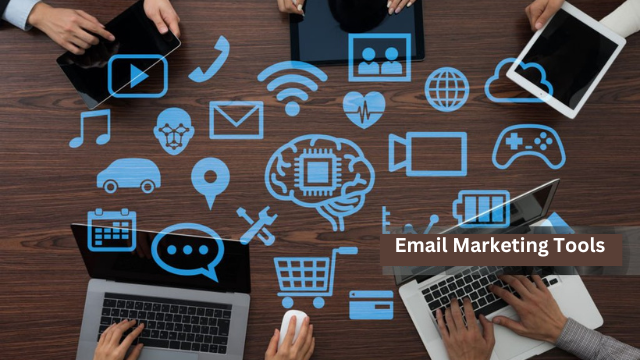

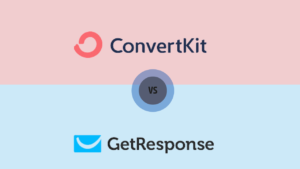
So much informative
Your recommendation is perfect
The article has deep insight on E-commerce and Email Marketing Tools
Incredibly informative and useful
The article found useful. Your recommendation is perfect
Your case studies on successful email campaigns have inspired me.
The post on the legal aspects of email marketing was informative.
Pingback: 8 Best Contact Forms For WordPress - Rx Blog
Pingback: GNC Creatine
Pingback: Xodo Sign - How To Edit PDF On Mac
Pingback: Amazon FBA Business for Sale
Pingback: Best VPN For Torrenting